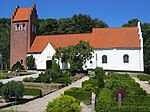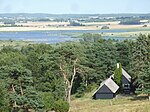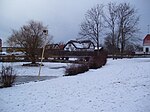Villa Vendle
1912 establishments in DenmarkHouses completed in 1912Houses in Gribskov MunicipalityListed buildings and structures in Gribskov MunicipalityListed residential buildings in Denmark

Villa Vendle is a country house in Tisvildeleje, Gribskov Municipality, some 50 kilometres northwest of Copenhagen, Denmark. Built for a retired eye surgeon in 1912 from a design by the architect Bent Helweg-Møller, the house is a typical and well-preserved example of the large summer residences which were built in the area for members of the upper middle-class in the 1910s. It was listed in the Danish registry of protected buildings and places in 2015. The garden borders on Hilkers Krog, part of Tisvilde Hegn.
Excerpt from the Wikipedia article Villa Vendle (License: CC BY-SA 3.0, Authors, Images).Villa Vendle
Ved Gærdet, Gribskov Municipality
Geographical coordinates (GPS) Address Nearby Places Show on map
Geographical coordinates (GPS)
| Latitude | Longitude |
|---|---|
| N 56.054944444444 ° | E 12.086305555556 ° |
Address
Ved Gærdet 1
3220 Gribskov Municipality
Capital Region of Denmark, Denmark
Open on Google Maps









